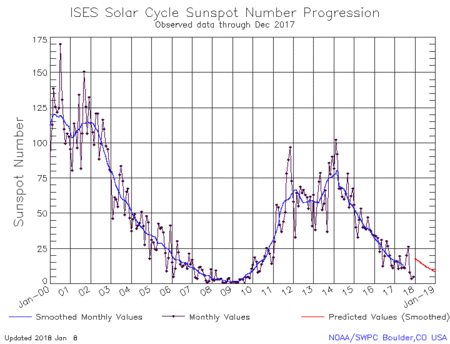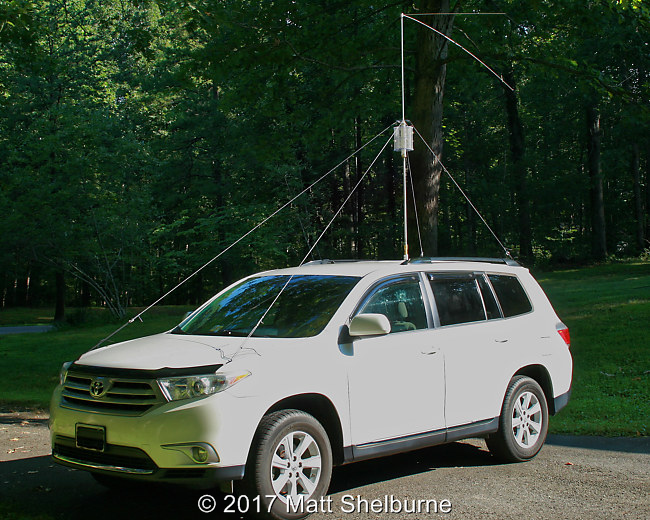Are all your eggs in one basket?
Anyone relying on near vertical incident skywave (NVIS) propagation for 24/7 radio circuits between any two points should heed the warnings found in the raw QSO data from the Virginia QSO Party.
Solar cycle downward trend
Dateline March 2015. We are well past the 2014 peak and heading only one direction… down.

As the previous solar maxima fades, all eyes fixate on the 40 and 80 meter bands for the lion’s share of contacts during the 2015 Virginia QSO Party on the air activity. It doesn’t dissapoint.
Happy… happy, happy, happy!
VaQP participants gleefully made plenty of contacts during the event, mostly on 40m with some 80m in mornings and late evening.

I announced on the QSOParty Spotting Network “40m is wide open.” The above data certainly suggests NVIS was in play for everyone. This includes instate contacts along with Virginia to the east coast.
Things not so good for Northern Virginia
For stations operating in and around my home county of Fauquier, NVIS crashed around the 4 pm hour Sunday afternoon.

The comment from Ross, N4RP, told the story as well as anyone. Our specific location suffered a partial NVIS blackout for over an hour while participants elsewhere never noticed. Myself (kx4o), Ross (n4rp) and many others witnessed total NVIS blackout.
I was at the controls of a friend’s very nice HF station when this ionosphere blackout occurred. I might as well have unplugged the radio as contact rate went to zero. It’s as if mother nature turned a knob down just for NoVA stations. By 6 pm everything returned to normal.
Data biases
It’s important to bear in mind there are many other biases in this data including the notion stations can only work a particular station once per band-mode-QTH. Perhaps the Fauquier stations simply ran out of new stations to log. That could be the assumption if we didn’t have first hand testimony stored in the QSO Party Spotting network to correlate. Interpret as you desire… YMMV. For some perspective here are the QSOs into Fauquier the following year.

Reasons for localized blackout
The study of the ionosphere is fascinating. Plenty of resources exist to help visualize changes over time.
- https://www.ngdc.noaa.gov/stp/iono/grams.html
- http://hflink.com/propagation/
- http://surf.colorado.edu/WI937.dcc
Exploring the reasons for the blackout we witnessed first hand is something best addressed in a separate research article. Given the complete shutdown of radio circuits not just at specific distances (aka skywave incident angles), but for all radio circuits, sporadic D-layer absorption may be the smoking gun. The key point of this article is to highlight the ionosphere stopped providing reliable NVIS communications for just over an hour without any particular warning.
Moral of the story – use all our bands
If nothing else, operating events like the Virginia QSO Party and other contests provide the operator with ample ionosphere experience. Managing your way around the propagation realities hones useful communication skills.
Don’t put all your eggs in one basket if you really need your radio circuits to function 24/7. Emcomm folks seem to often hang everything on NVIS propagation. The Virginia QSO Party data along with the spotting network testimonials reveal this is a risky endeavor. Certainly include NVIS in your collection of skills, but ensure you plan for when it goes south… because it will… then you’re stuck. No one needs or wants you to be a one-trick pony. We have bands from almost DC to Daylight. Innovate!
Conclusion
There’s an old saying that goes something like this…
Expect nothing and you will never be disappointed.
Well… that’s not great advice to follow, but a good reminder for us all to properly manage expectations including when and if the ionosphere works for our benefit.





NVIS operation is a function of the FoF2, the maximum frequency that will 'bounce' directly back. There are a number of reasons why 40 NVIS might fail; localized D layer ionization is one of a number of reasons that could be investigated. Did you QSY to 80 meters? I have found 80 to be very reliable for daytime NVIS with only 5 watts. 160 is also useable albeit with a bit more power, say 20 watts.
As everyone tries to keep their QSO rates up, 80m was certainly everyone's next band to try, but that didn't open till 5 pm or so. Some were on 160m, but there are too few QSOs to really have meaningful metrics. Given this is a "contest" 60m wasn't an option, but in hindsight it would be interesting to see if it was open.
I've noticed on the ionospheric sounder in Austin (and on others) that when a really good E-layer "shows up" then the F-layer 'returns' (the indications) on the sounder are minimized … so this may also be a factor that isn't often correlated. de A A 5 C T.
Most of my attempts at using NVIS antennas has been with an EMCOMM II end-feed 60ft about 10 ft off the ground. Wondering if using a counterpoise equal to the length of the antenna would make any difference. What would happen if the height above ground were lowered or raised? Wound an inverted V at 20ft center and 10 ft at each end make a difference during a locational blackout. Just curious if experimenting with antenna would be of any benefit.
My original post did not show up since I was not a member. I have been using a 60ft end-feed EMCOMM II at 10 feet off the ground with reasonable results. I was wondering if I experienced "blackout", would changing my antenna profile fix this? Maybe lower or raise it or add a ground counterpoise. I was going to try an MFJ 40/80m dipole at the same height and then try it as an inverted V with 20ft at feed point and 10ft on each end. Or the only other thing to try would be change band to 80m if on 40m. Not sure how much experimentation would help in a situation like the one described.
Certain antenna profiles can increase your signal strength to overcome weak skip conditions, but once the ionosphere shuts down, it's done until it comes back no matter what gear you have. Good gear is still good to have, we just have to understand HF will fail us if we rely on it 24/7.
I'm using a 85 foot endfed wire with center @ 15 feet and ends @ 6 feet Icom 120 Autotuner at end. Tuner is well grounded (driven rod) and ground wire laying on ground surface. Every portable if needed. Tunes everywhere for 10-160. Works quite well for instate Alaska contacts mostly on 80 meters. The autotuner is light but a little bulky. Ease of operation is terrific.
Two low, parallel dipoles half a wavelength apart make a proper high-angle radiator. Omnidirectional coverage to 400 km if 0.2-0.3 wavelength above ground level. But you need that 5 MHz frequency more than the 7 MHz.
Four such sets for 1.8-3.6-5-7 MHz will give you 24/7 cover for ever. Yes, the 1.8 MHz set is a non-trivial aerial.
Three sites in the Northern Territory ran 24/7 broadcast services from 1986-c.2015 using 2.3/5 MHz pairs with reliable OD range > 450 km. An additional 3.3 MHz channel was available, but never used.